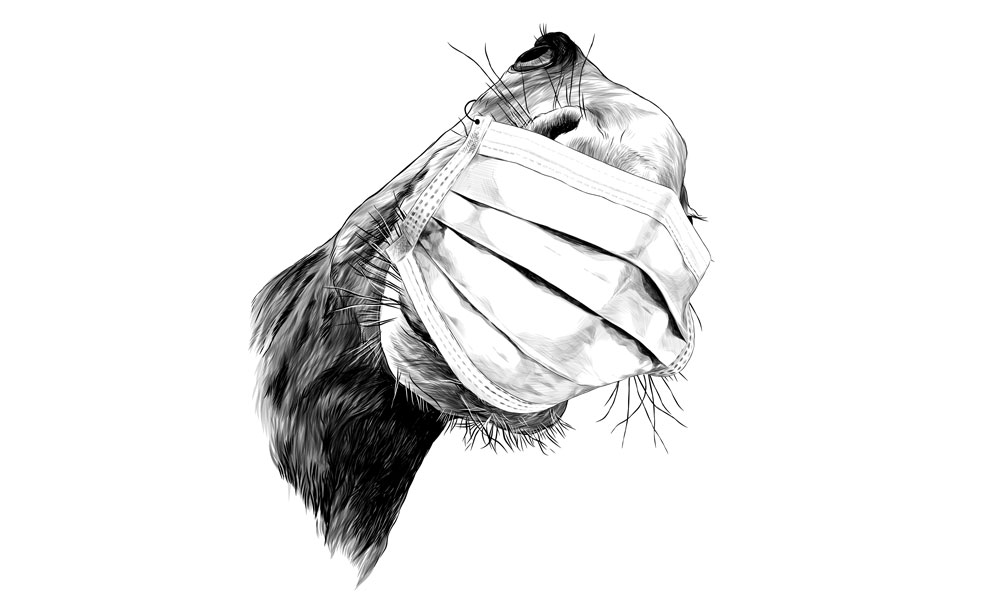
Social distancing, mask wearing, hand washing, and the dreaded nasal swab have become part of our normal life during the COVID-19 pandemic. The equine industry faces similar types of outbreaks but placing a mask on a horse isn’t feasible. However, there are ways to prevent disease spread within the equine community.
The recent increase in horses affected by herpesvirus neurologic disease in North America and Europe reminds us that equine herpesvirus (EHV-1) remains a constant threat for horses. The virus, which causes upper airway infection and abortion, is highly contagious and easily transmitted between horses. Although there are vaccines for this virus, these vaccines are not completely effective and do not protect against the neurologic form of the disease, which is often fatal. The best protection to limit the spread of this disease is appropriate biosecurity, including isolation and social distancing.
The Equine Disease Communication Center offers biosecurity reminders in a recently published article titled “Do We Need To Practice Social Distancing with Our Horses?” You can read the full article and share online by clicking here.
Like COVID-19, equine diseases such as equine herpesvirus and equine influenza are highly infectious and spread by contact or by inhalation of micro-organisms on particles in the air or water. When an infected horse coughs or sneezes, tiny particles are spread. Viral diseases can also be spread by horse-to-horse contact or by contamination on commonly touched surfaces.
Bacterial diseases such as Strangles are also transmitted through contact—from horse to horse or by horses touching common areas such as watering systems, tack and grooming equipment. Both viruses and bacteria can be spread by humans working with an affected horse and carrying it to other horses.
Keeping horses separated is one of the most important steps in biosecurity to help prevent disease spread. When an infectious disease is suspected or confirmed, all horses in the same facility or on the same premise are at risk of becoming infected. Keeping horses separated in stalls or at a separate facility is crucial to stop the transmission of disease to other horses. With very contagious diseases such as equine herpesvirus, a quarantine is often necessary to stop all horse movement and limit movement of people on the affected premises.
Social distancing only works if appropriate sanitation measures and careful separation of tools and equipment are in place while caring for infected horses. Just as hand washing is needed to help control COVID-19, it is important that hands, clothing and any objects that come in contact with more than one horse are sanitized or changed between horses.
If a horse is suspected or confirmed to have an infectious disease, horse owners should employ the following protocol to help prevent disease spread.
- Immediately isolate the horse showing signs of an infection.
- Implement movement restrictions of the affected horse and possibly exposed horses until the situation is evaluated.
- Contact your veterinarian or the event veterinarian and ask what you should do.
- Inventory horses, identify and isolate potentially exposed horses, and immediately implement health monitoring: take temperature twice daily (a temperature above 101.5° F suggests the horse has an infectious disease) and observe for clinical signs of depression or abnormal behavior.
- When more than one owner or caretaker is involved, establish communication with all parties.
Additional protocol detail is available in “What Horse Owners Should Do During the First 30 Minutes of a Suspected Infectious Disease Outbreak.” Save the document as a PDF to your mobile device for future reference at https://aaep.org/sites/default/files/WhatToDo_EDCC_Final.pdf.
About the Equine Disease Communication Center
The Equine Disease Communication Center, headquartered in Lexington, Kentucky, is an industry-driven initiative which works to protect horses and the horse industry from the threat of infectious diseases in North America. The communication system seeks and reports real-time information about diseases like how the Center for Disease Control and Prevention (CDC) alerts human population about disease in people. Donations are needed annually to support the EDCC staff and activity.
To donate go to the EDCC website support page or send your donation to The Foundation for the Horse, c/o Equine Disease Communication Center, 4033 Iron Works Pkwy, Lexington, KY 40511. The EDCC fund is maintained in The Foundation for the Horse and all donations are tax deductible.
Contact Katie McDaniel, EDCC communication manager at kmcdaniel@aaep.org for information on the EDCC or to donate


